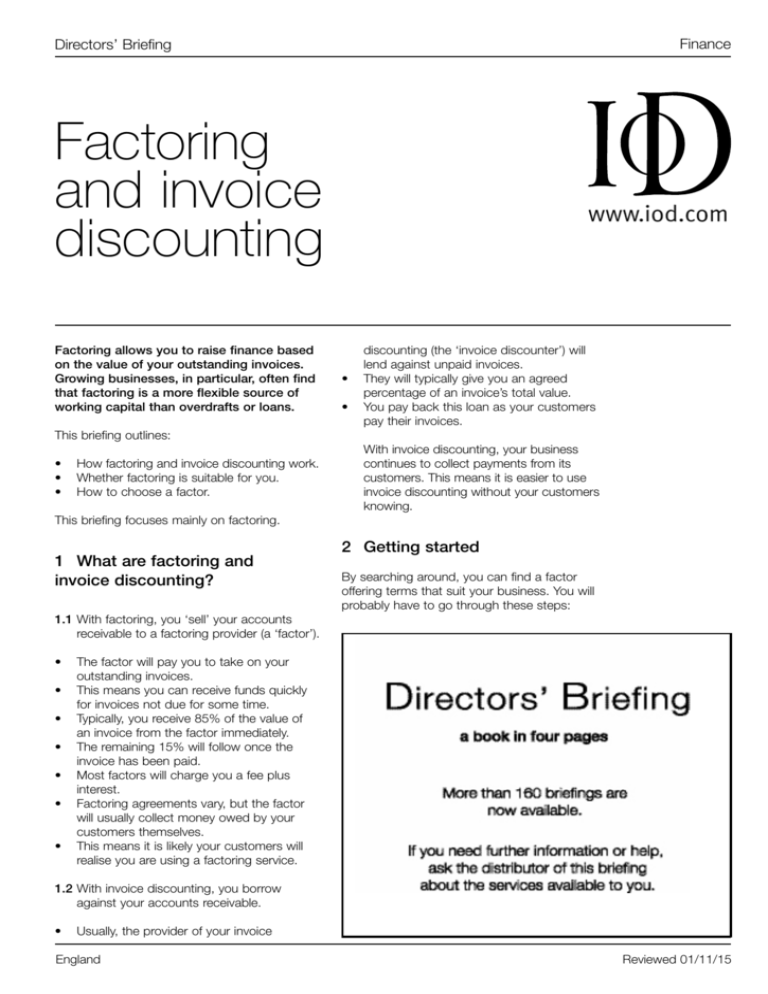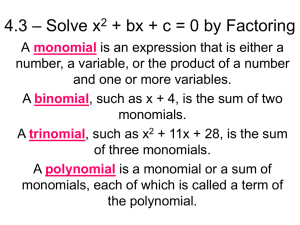
Finance
Directors’ Briefing
Factoring
and invoice
discounting
Factoring allows you to raise finance based
on the value of your outstanding invoices.
Growing businesses, in particular, often find
that factoring is a more flexible source of
working capital than overdrafts or loans.
discounting (the ‘invoice discounter’) will
lend against unpaid invoices.
• They will typically give you an agreed
percentage of an invoice’s total value.
• You pay back this loan as your customers
pay their invoices.
This briefing outlines:
• How factoring and invoice discounting work.
• Whether factoring is suitable for you.
• How to choose a factor.
With invoice discounting, your business
continues to collect payments from its
customers. This means it is easier to use
invoice discounting without your customers
knowing.
This briefing focuses mainly on factoring.
1 What are factoring and
invoice discounting?
2 Getting started
By searching around, you can find a factor
offering terms that suit your business. You will
probably have to go through these steps:
1.1With factoring, you ‘sell’ your accounts
receivable to a factoring provider (a ‘factor’).
• The factor will pay you to take on your
outstanding invoices.
• This means you can receive funds quickly
for invoices not due for some time.
• Typically, you receive 85% of the value of
an invoice from the factor immediately.
• The remaining 15% will follow once the
invoice has been paid.
• Most factors will charge you a fee plus
interest.
• Factoring agreements vary, but the factor
will usually collect money owed by your
customers themselves.
• This means it is likely your customers will
realise you are using a factoring service.
1.2With invoice discounting, you borrow
against your accounts receivable.
• Usually, the provider of your invoice
England
Reviewed 01/11/15
Directors’ Briefing
2.1The factor will audit your books to establish
that your sales ledger meets its criteria.
• Most companies that use factoring have a
turnover of more than £200,000.
Some factors will consider start-ups and
companies with a lower turnover.
• Generally you should not have just a few
customers and no one debtor should
account for more than 25-40% of your
business.
• Factors usually only provide finance to
businesses with commercial customers
(business-to-business).
Providers prefer companies that offer
industry standard credit terms.
• You should be collecting your debts within
a reasonable timeframe. For instance, 30
days. Businesses paid in stages, or whose
2
bills are often questioned, may not be able
to use factoring.
• Lots of small invoices may make it
uneconomical.
• If your sales are declining then it might be
hard to justify factoring.
2.2Where credit limits are required by the
factor, you must agree how they will be
handled.
Invoice discounting
• For non-recourse factoring (where the
factor protects you against bad debts), the
factor will usually set credit limits for each
customer.
The factor will use its credit system to
determine the creditworthiness of your
customers.
• Many factors offering recourse factoring
(where you are not protected against bad
debts) do not agree credit limits.
Invoice discounting helps you to keep
control and confidentiality over your own
sales ledger operations.
2.3The way you handle invoicing and payment
with customers will depend on your
agreement with the factor.
A You collect your own debts.
• Often, you invoice as normal and send a
copy of the invoice to the factor.
• Most factoring arrangements require you to
factor all your sales.
• ‘Confidential invoice discounting’ hides
the fact that you are using invoice
discounting from your customers.
• You send out invoices and statements
as usual.
• The invoice discounter makes a
proportion of the invoice available to you
once it receives a copy of an invoice you
have sent.
• Once you receive payment, you must
deposit the funds in a bank account
controlled by the invoice discounter.
• The invoice discounter will then pay you
the remainder of the invoice, less any
charges.
B The requirements are more demanding.
Different invoice discounters will have
different requirements. Typically:
• Your annual turnover must be over
£500,000 and in some cases exceed £1
million.
• The invoice discounter will regularly
audit your books (usually every three
months) to check that your credit control
procedures are adequate.
• You must have a minimum net worth of
£30,000.
• Your business must be profitable.
The requirements for ‘disclosed’ (ie
non-confidential) invoice discounting are
generally less demanding.
2.4The factor will pay a set proportion of the
invoice value within an agreed time.
2.5With factoring, the factor issues statements
on your behalf and collects payments.
• This includes contacting late payers by
phone and chasing invoices (see 7.2).
• You remain responsible for repaying the
factor for bad debts, unless you have
arranged a ‘non-recourse’ facility (see 3.5).
2.6With invoice discounting, you collect
payments from customers as normal.
• As customers pay invoices, you pay this
money to the invoice discounter.
• This reduces what you owe, which may
then allow you to borrow against more
recent invoices.
3 The advantages
3.1You maximise your cash flow.
• Factoring enables you to raise money
immediately - often up to 85% of invoice
value.
An overdraft secured against invoices
would probably raise up to only 50%.
Directors’ Briefing
3.2You negotiate a credit line that can grow
with your sales.
• Bank finance has to be renegotiated
frequently.
3.3Using a factor can reduce the time and
money you spend on debt collection.
• The factor will usually run your sales ledger.
You retain your own sales ledger operations
if you opt for invoice discounting (see box).
Export factoring
Export factoring helps you minimise the risk
of doing business overseas by relying upon
a factor to collect payments.
You can use export factoring to bypass the
complexities of export finance and offer your
customers ‘open account’ trading.
A The turnover requirements are usually
higher than with UK factoring.
• Typically, you must have a total annual
turnover of at least £100,000.
• Within the EU, it is possible to factor
debts with relatively small sales to any
one country.
• For other countries, higher sales to that
country will be required.
B You can choose to invoice in one
currency and be paid in another.
• Many customers will prefer quotes in
their own currency.
• You can protect yourself against
currency variations.
C The cost of export factoring compares
favourably with the cost of export
finance.
• The cost of export factoring is typical
marginally higher than the cost of
domestic factoring.
D You can minimise the risk of nonpayment by purchasing credit protection.
• Using an export factor’s credit protection
systems can be cheaper than using
specialised export finance.
• Most factors will insist that you purchase
credit protection.
3
3.4You can use the factor’s credit control
system to assess the creditworthiness of
customers.
• This is useful if you do business with
companies that do not have to file full
returns with Companies House.
3.5You can purchase ‘non-recourse’ factoring
to protect yourself against bad debts.
3.6Factoring can be an efficient way to
minimise the cost and risk of doing
business overseas (see box).
4 The costs
4.1Finance charges should be comparable to
an overdraft.
• Typical charges range from 1.5-3% over
base rate, with interest calculated daily.
4.2Credit management and administration
charges depend on your turnover, the
volume of your invoices and the number of customers that you have.
• Typical fees range from 0.75-2.5% of
annual turnover.
A company with 50 live customers, 1,000
invoices per year and £1 million turnover
might pay 1%.
For invoice discounting where only finance
is provided, administration fees range
from 0.2-0.5% of annual turnover. This is
because you collect and manage payments
yourself.
4.3Credit protection charges (for non-recourse
factoring) largely depend on the degree
of risk the factor associates with your
business. Typical charges range from
0.5-2% of annual turnover.
5 The disadvantages
Unless carefully implemented, factoring
can negatively affect the way your business
operates.
5.1The factor usually takes over the
maintenance of your sales ledger.
• Customers may prefer to deal with you.
You can avoid problems by clearly agreeing
things with the factor upfront.
Directors’ Briefing
4
5.2Factoring may impose constraints on the
way you do business.
of such an intimate working relationship can be
complicated and expensive.
Expert
contributors
• Most factors will want to pre-approve
customers, which may cause delays.
The factor will apply credit limits to
individual customers. These should be
reasonable and fair.
7.1Check that the factor’s performance is will
be satisfactory.
Thanks to
(BCR Publishing, 020
8466 6987)
5.3You may only want the finance
arrangements, but unless your operations
are big enough to justify invoice
discounting, you may feel you are paying
for collection services you do not need.
5.4Ending a factoring arrangement can be
difficult.
• Your only exit route is to repurchase your
sales ledger or to switch factors.
• Cash flow can be an issue, as you need to
find a way to make up the sudden shortfall
in working capital.
6 Picking a factor
Talk to and get quotes from several factors
before you make a decision.
6.1The Asset Based Finance Association can
provide a list of factors (020 8332 9955 or
www.abfa.org.uk).
There are many independent factoring and
invoice discounting companies, as well as
subsidiaries of the major banks.
• A factoring broker can advise you and may
be able to negotiate a better deal.
Most brokers will do this free (as they
receive commission).
6.2Confirm that the factor offers the services
you want, at the right price.
• Ask how their credit-control systems work.
Will the factor want to pre-approve
customers? What credit limits will the factor
set? How quickly will they make decisions?
• Confirm each factor’s proposed finance,
credit management and protection charges.
These will be negotiable and should reduce
as your turnover grows.
Some factors may want to charge you for a
survey of your debtor book.
7 Before you sign up
• Does the factor have experience of your
industry?
• How will you communicate with the factor?
What reports will you receive? What
information will you have to provide? How
often will you and the factor meet?
• How quickly does the factor collect debts?
How does this compare with your own
debt collection system?
• How flexible will the factor’s methods be?
What is the factor’s idea of ‘quick
response’? What will happen if customers
breach their credit limits? What will happen
if you want a customer’s credit limit
increased?
• What will happen if the factor’s performance
is unsatisfactory? For example, will you end
up paying charges for debts the factor has
failed to collect?
Ask for references and telephone some of
the factor’s existing customers.
7.2Discuss how the factor will handle debt
collection.
• When will statements be sent out?
• What happens if a customer disputes an
invoice?
• How will the factor follow up overdue
debts? What letters will be sent and what
phone calls will be made?
• What will happen when a customer’s
payments are seriously overdue?
• What form will the final reminder take and
when will it be sent?
• What further action will the factor use to
collect overdue debts?
• Will a collection agency be used?
• Will legal action be taken?
7.3Read the factoring agreement carefully,
confirm the terms and conditions for
ending the factoring arrangement and
make sure they are clear. If in doubt, take
legal advice.
• What would happen if you wanted to
change factors?
There may be a notice period (typically
three months) and a fee.
• What would happen if you wanted to
change the services provided by the factor?
Once you have chosen a factor, make a detailed
check before you commit yourself. Getting out
Published by Atom Content Marketing Ltd, CityPoint, Temple Gate, Bristol, BS1 6PL
Tel: 01117 373 6160, http://atomcontentmarketing.co.uk
© Atom Content Marketing
Ltd 2015. ISSN 1369-1996.
All rights reserved. No
part of this publication
may be reproduced or
transmitted without the
written permission of the
publisher. This publication
is for general guidance
only. The publisher, expert
contributors and distributor
disclaim all liability for
any errors or omissions.
Consult your local business
support organisation or your
professional adviser for help
and advice.









